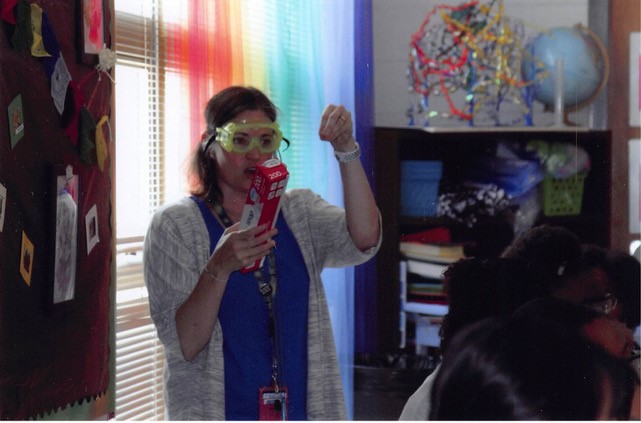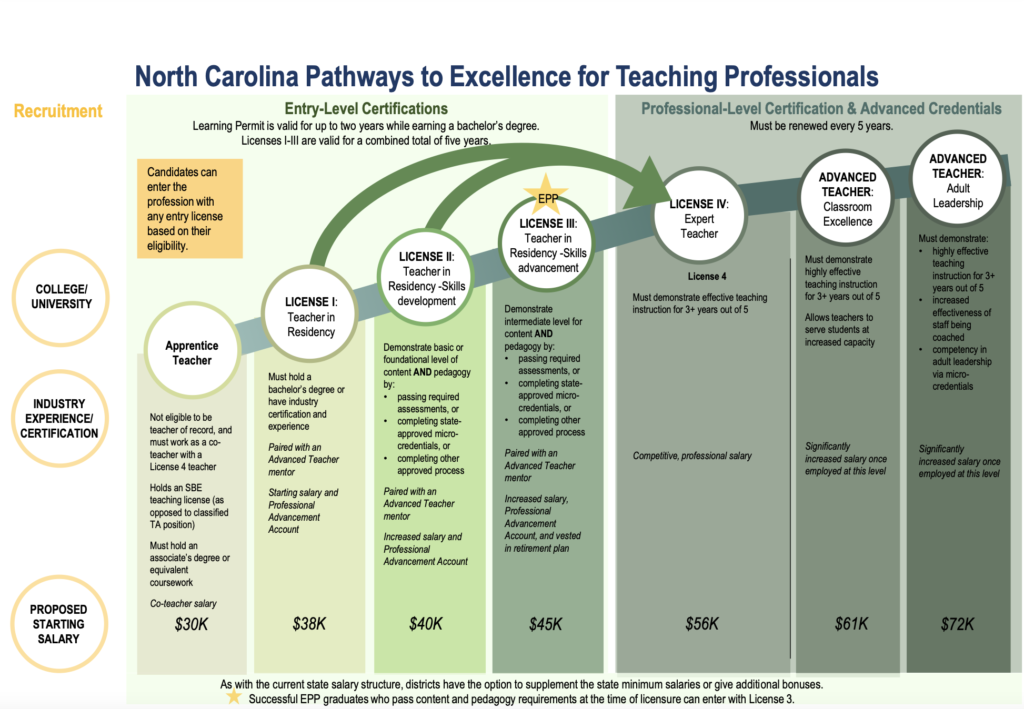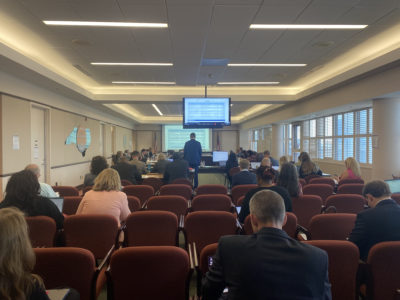
Teaching is my ikigai. In Japanese culture, ikigai is your reason for being. It is the thing that motivates you, the thing that defines you, and the thing that brings you joy.
My ikigai is my students and teaching, but I also find purpose in mentoring pre-service and beginning teachers, facilitating professional development, and serving on boards and committees to provide a practitioner’s perspective. Each of these opportunities has enabled me to grow in my teaching practice and has allowed me to share my experience as a teacher with my colleagues.
When I was first introduced to the Pathways to Excellence Licensure model, I was excited because I felt that it was designed for a teacher like me — someone who wants leadership opportunities without going into administration. As I continued to learn more about the model, I realized the incredible potential and positive impact it could have on every teacher from pre-service through veteran in North Carolina.
The Pathways to Excellence model proposes to shift our current licensure system to a multi-level, impact-based system with increased support for beginning through twilight career teachers and increased leadership opportunities for classroom teachers.
- Early career teachers would benefit from mentoring and support, including a personal professional development account.
- Veteran teachers would have opportunities to serve as a classroom excellence teacher or as an adult leadership teacher.
- Classroom excellence teachers would be compensated for their ability to demonstrate multi-year, positive impact on the students they teach and for opening their classrooms to model lessons for other teachers.
- Adult leadership teachers would shift from working predominately with students to working with adults. These teachers would have dedicated time during the school day to engage with other teachers, including at least five hours per week working one-on-one with beginning teachers. They would be instructional leaders who support, co-teach, model teach, and mentor other teachers.
The design of this model would enable teachers to continuously improve our profession from within through mentorship, support, and collaboration designed to help teachers improve their practice.
Choice is important, and this innovative licensure model prioritizes choice in the teaching profession. The model enables teachers to choose professional development that aligns with their unique needs and empowers teachers to choose the evidence they want to submit to demonstrate their positive impact on students. Just as our students benefit from differentiated learning and demonstrate standards mastery in different ways, our teachers have unique professional development needs and demonstrate their impact on students in different ways. Early career teachers in license 1, license 2, and license 3 would not only have increased support from an adult leadership teacher, but they would also have a personal professional development account that they can use to engage in the classes, conferences, or professional development that best align with their professional needs.

Teachers would choose how they demonstrate their impact on the students they teach from menu of options that provide evidence of their impact. This means that if one of the options does not accurately reflect how students improved during the school year, teachers would have the ability to select another measurement option that does.
The Pathways to Excellence model would increase teacher compensation at all levels, including apprentice teachers. The proposed starting pay for a license 1 teacher is $38,000 per year. As teachers progress through their career, they would continue to earn additional pay at each level with the potential to earn $72,000 as a license 4 Adult Leadership Teacher. The pay scale compensates teachers for the additional duties they fulfill and for demonstrating a positive impact on the students they teach. Once teachers achieve a license 4, they would earn a $5,000 pay raise when they successfully renew on a 5-year cycle — that’s where experience comes into compensation.
Hold harmless agreements are proposed to ensure currently licensed teachers’ pay would not decrease from what they are earning under the current model. The proposed pay scale compensates teachers for the workload they carry and their expertise in designing instruction that has a positive impact on students. It also ensures teachers would be eligible for consistent raises throughout their career.
One of the goals in reimaging licensure is to reduce barriers to entering the education career field, such as the PRAXIS exam requirement. The PRAXIS exam would still be an option to enter the career field, but teachers would have additional ways to demonstrate their competency in content and pedagogy. This modification to the current licensure system means that teachers who struggle to pass an exam, but who have demonstrated their ability to be effective classroom practitioners, would be able to remain in the classroom. Under the current model, if a teacher is effective in the classroom, but unable to pass the exam, they can no longer teach. The Pathways to Excellence model removes this barrier by providing alternative ways for a teacher to demonstrate their ability to teach effectively.
The new model revolutionizes the way we support and compensate our teachers. It provides opportunities to develop teacher-leaders while fully supporting every teacher in our workforce. However, the model is still a draft. Four subcommittees — Advancement & Development (which I co-chair), Licensure (which I serve on), Budget & Compensation, and Preparation & Entry — are developing the model. Once the subcommittees complete their work, the final draft will go before the Professional Educators Preparation and Standards Commission (PEPSC) for approval. If it is approved by PEPSC, then the draft will go before the State Board of Education for approval, and then finally, legislation will be introduced in the General Assembly.
To build a robust model that enables North Carolina’s teachers to fully support our students, we need educators’ input and feedback to ensure your ideas are considered as the model is drafted. Together, we can develop a new licensure system that empowers our teachers to support our students and improve the educational opportunities for all 1.5 million students enrolled in North Carolina’s public schools.




